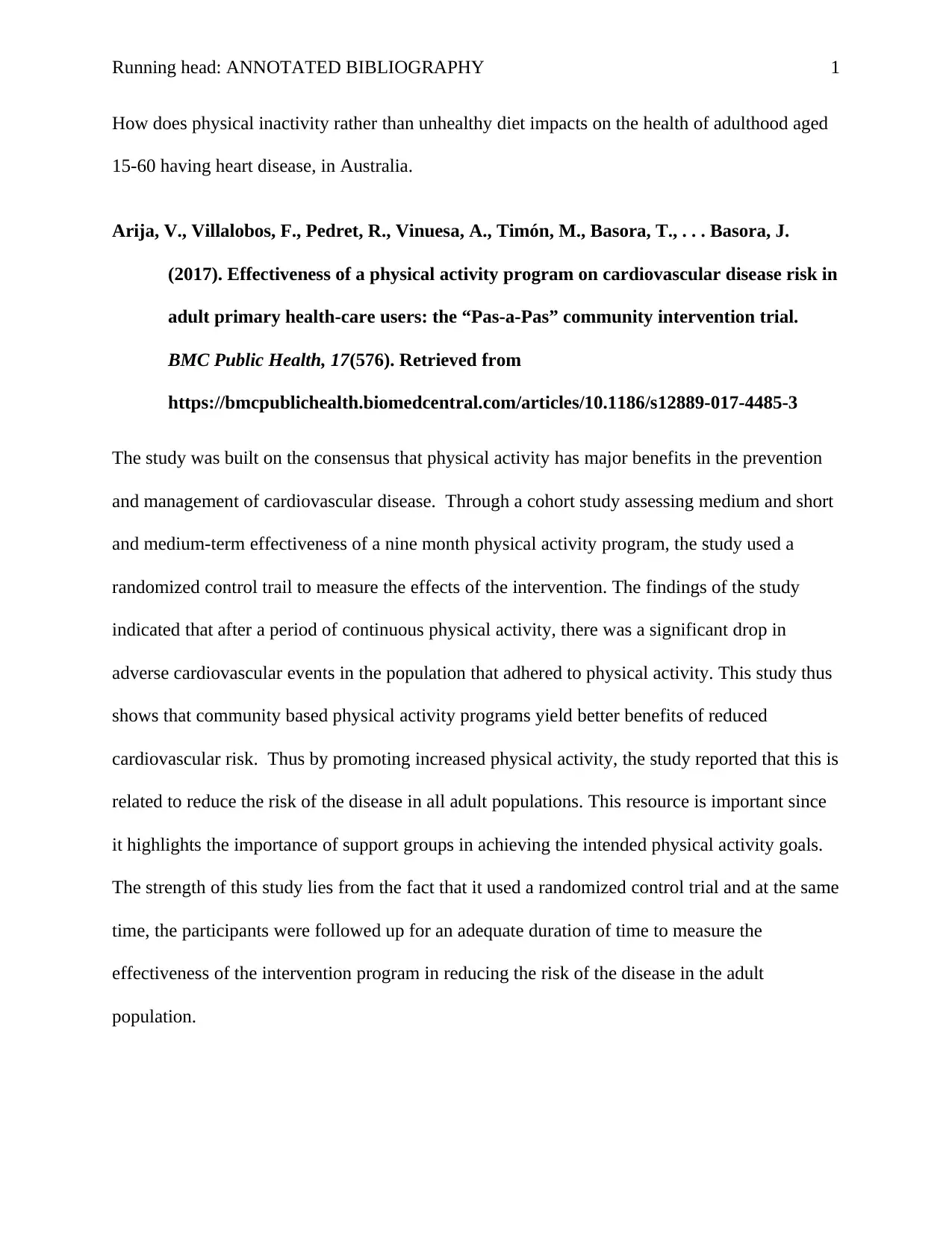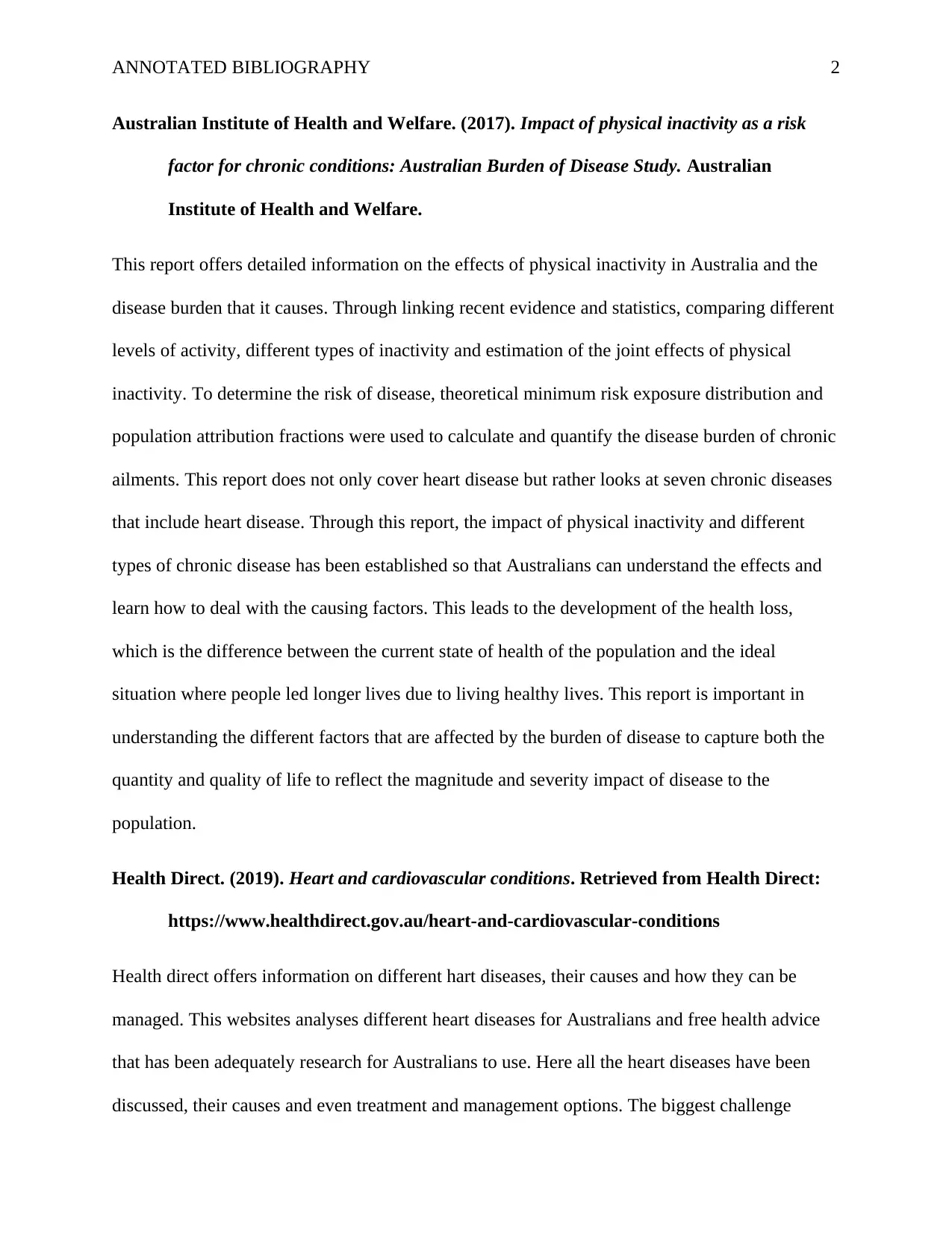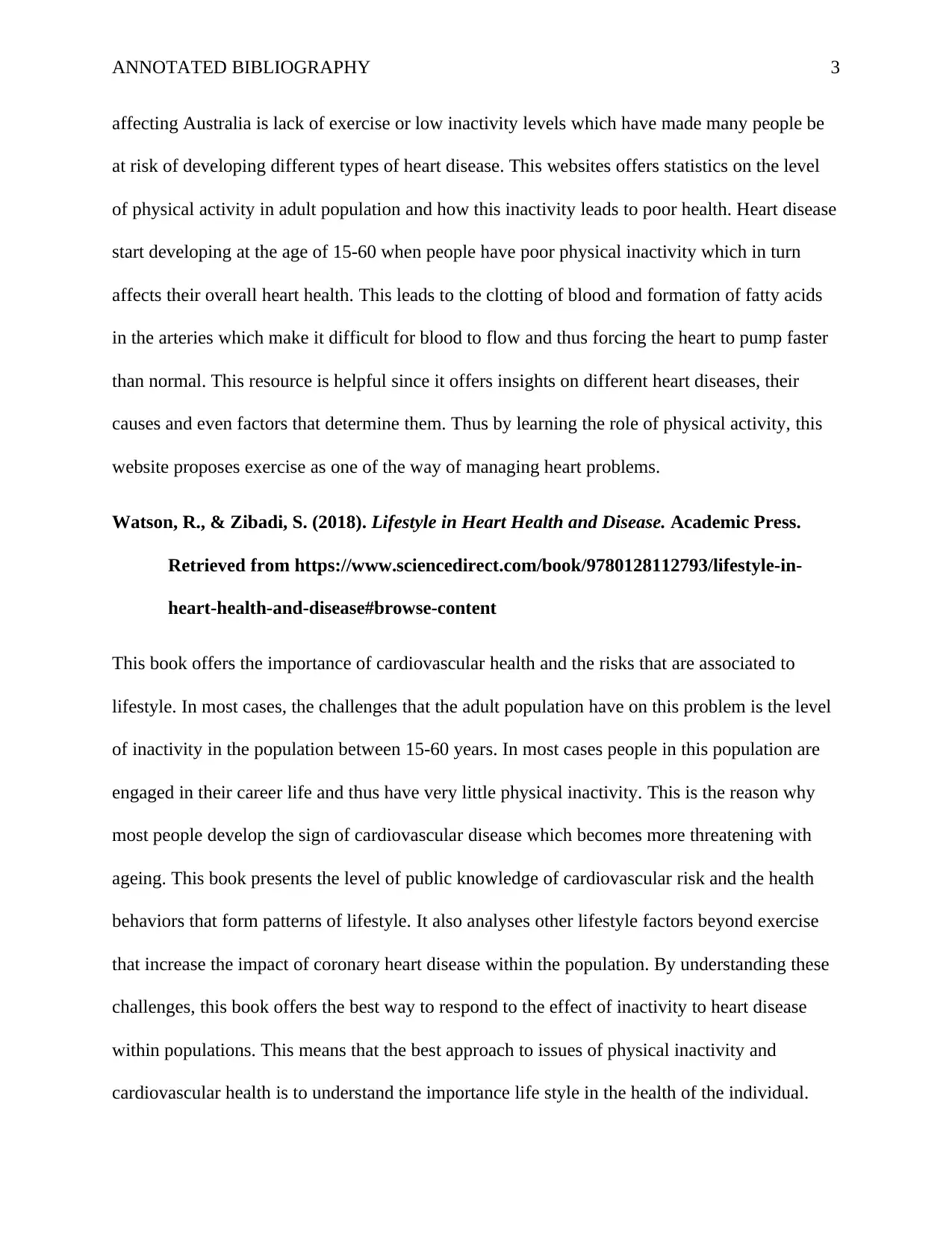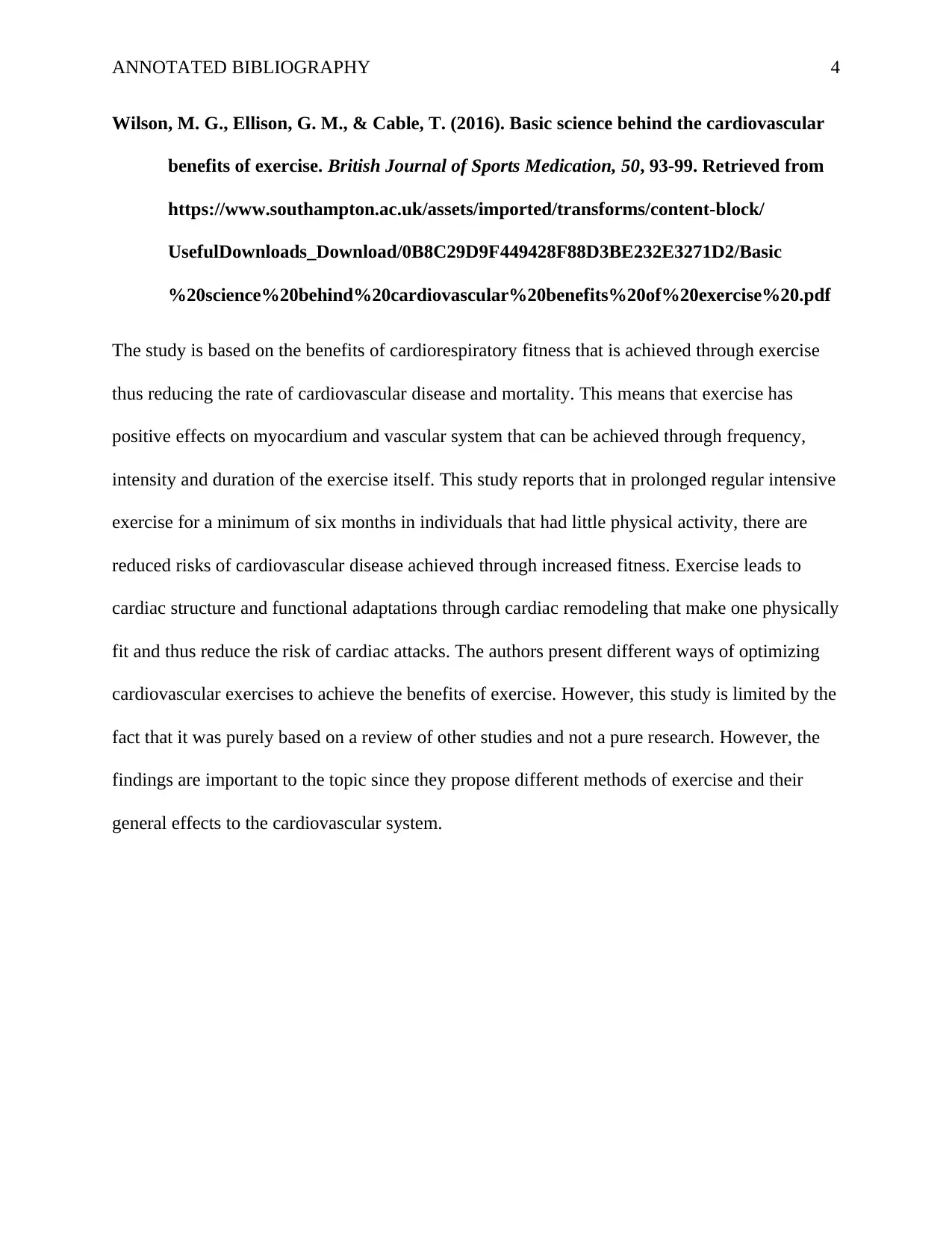Annotated Bibliography on Physical Inactivity and Heart Disease
VerifiedAdded on 2023/01/04
|4
|1236
|23
Annotated Bibliography
AI Summary
This annotated bibliography examines the relationship between physical inactivity and heart disease in Australian adults aged 15-60. It includes an analysis of several research papers and reports, such as studies on the effectiveness of physical activity programs in reducing cardiovascular risk, the impact of physical inactivity on chronic conditions, and the role of lifestyle factors in heart health. The bibliography also references resources providing information on different heart diseases, their causes, and management options, highlighting the importance of exercise and lifestyle modifications in preventing and managing heart disease. The selected sources provide insights into the benefits of exercise on the cardiovascular system and the risks associated with physical inactivity, emphasizing the need for increased physical activity to reduce the risk of heart disease.

Running head: ANNOTATED BIBLIOGRAPHY 1
How does physical inactivity rather than unhealthy diet impacts on the health of adulthood aged
15-60 having heart disease, in Australia.
Arija, V., Villalobos, F., Pedret, R., Vinuesa, A., Timón, M., Basora, T., . . . Basora, J.
(2017). Effectiveness of a physical activity program on cardiovascular disease risk in
adult primary health-care users: the “Pas-a-Pas” community intervention trial.
BMC Public Health, 17(576). Retrieved from
https://bmcpublichealth.biomedcentral.com/articles/10.1186/s12889-017-4485-3
The study was built on the consensus that physical activity has major benefits in the prevention
and management of cardiovascular disease. Through a cohort study assessing medium and short
and medium-term effectiveness of a nine month physical activity program, the study used a
randomized control trail to measure the effects of the intervention. The findings of the study
indicated that after a period of continuous physical activity, there was a significant drop in
adverse cardiovascular events in the population that adhered to physical activity. This study thus
shows that community based physical activity programs yield better benefits of reduced
cardiovascular risk. Thus by promoting increased physical activity, the study reported that this is
related to reduce the risk of the disease in all adult populations. This resource is important since
it highlights the importance of support groups in achieving the intended physical activity goals.
The strength of this study lies from the fact that it used a randomized control trial and at the same
time, the participants were followed up for an adequate duration of time to measure the
effectiveness of the intervention program in reducing the risk of the disease in the adult
population.
How does physical inactivity rather than unhealthy diet impacts on the health of adulthood aged
15-60 having heart disease, in Australia.
Arija, V., Villalobos, F., Pedret, R., Vinuesa, A., Timón, M., Basora, T., . . . Basora, J.
(2017). Effectiveness of a physical activity program on cardiovascular disease risk in
adult primary health-care users: the “Pas-a-Pas” community intervention trial.
BMC Public Health, 17(576). Retrieved from
https://bmcpublichealth.biomedcentral.com/articles/10.1186/s12889-017-4485-3
The study was built on the consensus that physical activity has major benefits in the prevention
and management of cardiovascular disease. Through a cohort study assessing medium and short
and medium-term effectiveness of a nine month physical activity program, the study used a
randomized control trail to measure the effects of the intervention. The findings of the study
indicated that after a period of continuous physical activity, there was a significant drop in
adverse cardiovascular events in the population that adhered to physical activity. This study thus
shows that community based physical activity programs yield better benefits of reduced
cardiovascular risk. Thus by promoting increased physical activity, the study reported that this is
related to reduce the risk of the disease in all adult populations. This resource is important since
it highlights the importance of support groups in achieving the intended physical activity goals.
The strength of this study lies from the fact that it used a randomized control trial and at the same
time, the participants were followed up for an adequate duration of time to measure the
effectiveness of the intervention program in reducing the risk of the disease in the adult
population.
Paraphrase This Document
Need a fresh take? Get an instant paraphrase of this document with our AI Paraphraser

ANNOTATED BIBLIOGRAPHY 2
Australian Institute of Health and Welfare. (2017). Impact of physical inactivity as a risk
factor for chronic conditions: Australian Burden of Disease Study. Australian
Institute of Health and Welfare.
This report offers detailed information on the effects of physical inactivity in Australia and the
disease burden that it causes. Through linking recent evidence and statistics, comparing different
levels of activity, different types of inactivity and estimation of the joint effects of physical
inactivity. To determine the risk of disease, theoretical minimum risk exposure distribution and
population attribution fractions were used to calculate and quantify the disease burden of chronic
ailments. This report does not only cover heart disease but rather looks at seven chronic diseases
that include heart disease. Through this report, the impact of physical inactivity and different
types of chronic disease has been established so that Australians can understand the effects and
learn how to deal with the causing factors. This leads to the development of the health loss,
which is the difference between the current state of health of the population and the ideal
situation where people led longer lives due to living healthy lives. This report is important in
understanding the different factors that are affected by the burden of disease to capture both the
quantity and quality of life to reflect the magnitude and severity impact of disease to the
population.
Health Direct. (2019). Heart and cardiovascular conditions. Retrieved from Health Direct:
https://www.healthdirect.gov.au/heart-and-cardiovascular-conditions
Health direct offers information on different hart diseases, their causes and how they can be
managed. This websites analyses different heart diseases for Australians and free health advice
that has been adequately research for Australians to use. Here all the heart diseases have been
discussed, their causes and even treatment and management options. The biggest challenge
Australian Institute of Health and Welfare. (2017). Impact of physical inactivity as a risk
factor for chronic conditions: Australian Burden of Disease Study. Australian
Institute of Health and Welfare.
This report offers detailed information on the effects of physical inactivity in Australia and the
disease burden that it causes. Through linking recent evidence and statistics, comparing different
levels of activity, different types of inactivity and estimation of the joint effects of physical
inactivity. To determine the risk of disease, theoretical minimum risk exposure distribution and
population attribution fractions were used to calculate and quantify the disease burden of chronic
ailments. This report does not only cover heart disease but rather looks at seven chronic diseases
that include heart disease. Through this report, the impact of physical inactivity and different
types of chronic disease has been established so that Australians can understand the effects and
learn how to deal with the causing factors. This leads to the development of the health loss,
which is the difference between the current state of health of the population and the ideal
situation where people led longer lives due to living healthy lives. This report is important in
understanding the different factors that are affected by the burden of disease to capture both the
quantity and quality of life to reflect the magnitude and severity impact of disease to the
population.
Health Direct. (2019). Heart and cardiovascular conditions. Retrieved from Health Direct:
https://www.healthdirect.gov.au/heart-and-cardiovascular-conditions
Health direct offers information on different hart diseases, their causes and how they can be
managed. This websites analyses different heart diseases for Australians and free health advice
that has been adequately research for Australians to use. Here all the heart diseases have been
discussed, their causes and even treatment and management options. The biggest challenge

ANNOTATED BIBLIOGRAPHY 3
affecting Australia is lack of exercise or low inactivity levels which have made many people be
at risk of developing different types of heart disease. This websites offers statistics on the level
of physical activity in adult population and how this inactivity leads to poor health. Heart disease
start developing at the age of 15-60 when people have poor physical inactivity which in turn
affects their overall heart health. This leads to the clotting of blood and formation of fatty acids
in the arteries which make it difficult for blood to flow and thus forcing the heart to pump faster
than normal. This resource is helpful since it offers insights on different heart diseases, their
causes and even factors that determine them. Thus by learning the role of physical activity, this
website proposes exercise as one of the way of managing heart problems.
Watson, R., & Zibadi, S. (2018). Lifestyle in Heart Health and Disease. Academic Press.
Retrieved from https://www.sciencedirect.com/book/9780128112793/lifestyle-in-
heart-health-and-disease#browse-content
This book offers the importance of cardiovascular health and the risks that are associated to
lifestyle. In most cases, the challenges that the adult population have on this problem is the level
of inactivity in the population between 15-60 years. In most cases people in this population are
engaged in their career life and thus have very little physical inactivity. This is the reason why
most people develop the sign of cardiovascular disease which becomes more threatening with
ageing. This book presents the level of public knowledge of cardiovascular risk and the health
behaviors that form patterns of lifestyle. It also analyses other lifestyle factors beyond exercise
that increase the impact of coronary heart disease within the population. By understanding these
challenges, this book offers the best way to respond to the effect of inactivity to heart disease
within populations. This means that the best approach to issues of physical inactivity and
cardiovascular health is to understand the importance life style in the health of the individual.
affecting Australia is lack of exercise or low inactivity levels which have made many people be
at risk of developing different types of heart disease. This websites offers statistics on the level
of physical activity in adult population and how this inactivity leads to poor health. Heart disease
start developing at the age of 15-60 when people have poor physical inactivity which in turn
affects their overall heart health. This leads to the clotting of blood and formation of fatty acids
in the arteries which make it difficult for blood to flow and thus forcing the heart to pump faster
than normal. This resource is helpful since it offers insights on different heart diseases, their
causes and even factors that determine them. Thus by learning the role of physical activity, this
website proposes exercise as one of the way of managing heart problems.
Watson, R., & Zibadi, S. (2018). Lifestyle in Heart Health and Disease. Academic Press.
Retrieved from https://www.sciencedirect.com/book/9780128112793/lifestyle-in-
heart-health-and-disease#browse-content
This book offers the importance of cardiovascular health and the risks that are associated to
lifestyle. In most cases, the challenges that the adult population have on this problem is the level
of inactivity in the population between 15-60 years. In most cases people in this population are
engaged in their career life and thus have very little physical inactivity. This is the reason why
most people develop the sign of cardiovascular disease which becomes more threatening with
ageing. This book presents the level of public knowledge of cardiovascular risk and the health
behaviors that form patterns of lifestyle. It also analyses other lifestyle factors beyond exercise
that increase the impact of coronary heart disease within the population. By understanding these
challenges, this book offers the best way to respond to the effect of inactivity to heart disease
within populations. This means that the best approach to issues of physical inactivity and
cardiovascular health is to understand the importance life style in the health of the individual.
⊘ This is a preview!⊘
Do you want full access?
Subscribe today to unlock all pages.

Trusted by 1+ million students worldwide

ANNOTATED BIBLIOGRAPHY 4
Wilson, M. G., Ellison, G. M., & Cable, T. (2016). Basic science behind the cardiovascular
benefits of exercise. British Journal of Sports Medication, 50, 93-99. Retrieved from
https://www.southampton.ac.uk/assets/imported/transforms/content-block/
UsefulDownloads_Download/0B8C29D9F449428F88D3BE232E3271D2/Basic
%20science%20behind%20cardiovascular%20benefits%20of%20exercise%20.pdf
The study is based on the benefits of cardiorespiratory fitness that is achieved through exercise
thus reducing the rate of cardiovascular disease and mortality. This means that exercise has
positive effects on myocardium and vascular system that can be achieved through frequency,
intensity and duration of the exercise itself. This study reports that in prolonged regular intensive
exercise for a minimum of six months in individuals that had little physical activity, there are
reduced risks of cardiovascular disease achieved through increased fitness. Exercise leads to
cardiac structure and functional adaptations through cardiac remodeling that make one physically
fit and thus reduce the risk of cardiac attacks. The authors present different ways of optimizing
cardiovascular exercises to achieve the benefits of exercise. However, this study is limited by the
fact that it was purely based on a review of other studies and not a pure research. However, the
findings are important to the topic since they propose different methods of exercise and their
general effects to the cardiovascular system.
Wilson, M. G., Ellison, G. M., & Cable, T. (2016). Basic science behind the cardiovascular
benefits of exercise. British Journal of Sports Medication, 50, 93-99. Retrieved from
https://www.southampton.ac.uk/assets/imported/transforms/content-block/
UsefulDownloads_Download/0B8C29D9F449428F88D3BE232E3271D2/Basic
%20science%20behind%20cardiovascular%20benefits%20of%20exercise%20.pdf
The study is based on the benefits of cardiorespiratory fitness that is achieved through exercise
thus reducing the rate of cardiovascular disease and mortality. This means that exercise has
positive effects on myocardium and vascular system that can be achieved through frequency,
intensity and duration of the exercise itself. This study reports that in prolonged regular intensive
exercise for a minimum of six months in individuals that had little physical activity, there are
reduced risks of cardiovascular disease achieved through increased fitness. Exercise leads to
cardiac structure and functional adaptations through cardiac remodeling that make one physically
fit and thus reduce the risk of cardiac attacks. The authors present different ways of optimizing
cardiovascular exercises to achieve the benefits of exercise. However, this study is limited by the
fact that it was purely based on a review of other studies and not a pure research. However, the
findings are important to the topic since they propose different methods of exercise and their
general effects to the cardiovascular system.
1 out of 4
Related Documents
Your All-in-One AI-Powered Toolkit for Academic Success.
+13062052269
info@desklib.com
Available 24*7 on WhatsApp / Email
![[object Object]](/_next/static/media/star-bottom.7253800d.svg)
Unlock your academic potential
Copyright © 2020–2025 A2Z Services. All Rights Reserved. Developed and managed by ZUCOL.





